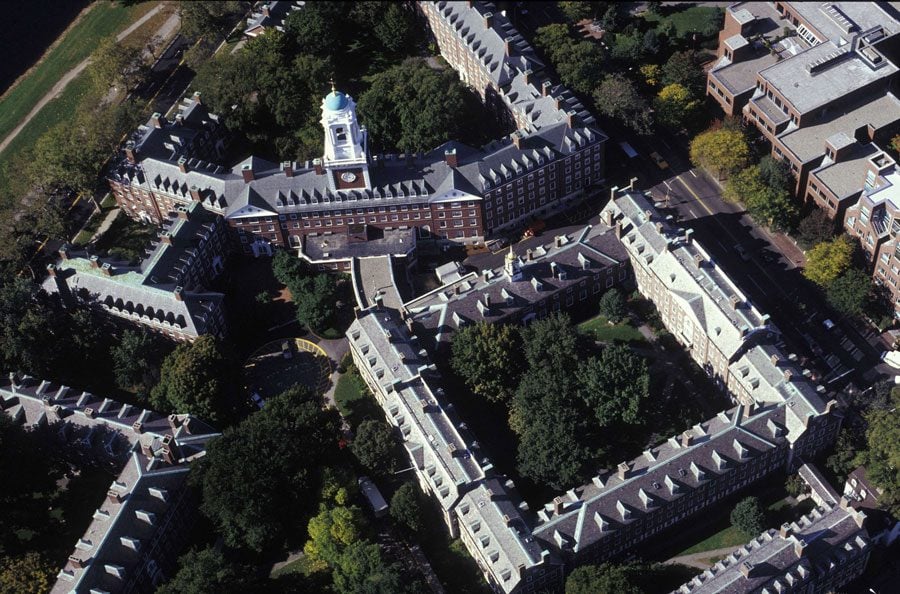Judge rules Harvard did not discriminate against Asian American applicants
Andrea Pistolesi/TIPS/Zuma Press/TNS
An aerial view of the Harvard University campus in 2013.
October 1, 2019
A federal judge Tuesday dismissed accusations of racial bias in Harvard University’s admission process, a win for the university at the center of the fight over the use of race-conscious admissions.
U.S. District Judge Allison Burroughs ruled that the school’s admission practices did not intentionally discriminate against Asian American applicants. In the 130-page ruling, Burroughs acknowledged Harvard had a legitimate interest in diversifying its student body to create “a more robust academic environment.”
“Harvard’s admission program passes constitutional muster in that it satisfies the dictates of strict scrutiny,” she wrote. “Race conscious admissions programs that survive strict scrutiny will have an important place in society and help ensure that colleges and universities can offer a diverse atmosphere that fosters learning, improves scholarship and encourages mutual respect and understanding.”
A group of Asian American students — aided by Students for Fair Admissions — brought the suit against Harvard, alleging the admissions committee unfairly held them to higher standards. The weeks-long trial uncovered deep and sometimes embarrassing practices by the undergraduate admissions committee, which the plaintiffs pointed to as evidence of discrimination.
The suit made national news for its potential to overthrow the use of race-conscious admissions, driving college and university administrators to Harvard’s defense. Northwestern officials had said that the outcome would not affect the admission practices of Northwestern, though University President Morton Schapiro and Provost Jonathan Holloway both expressed a level of concern that the ruling would reign in the use of race.
A University spokesperson was not available for comment Tuesday afternoon.
The ruling will likely be appealed by SFFA and could make its way up to the U.S. Supreme Court. The plaintiffs were also aided by longtime anti-affirmative action activist Edward Blum, who last tackled the policy in front of the high court in 2016.
In that case, the Supreme Court, led by Justice Anthony Kennedy, ruled that the use of race was lawful if it was necessary to achieve the benefits of diversity and no race-neutral alternative was sufficient. The court has long held that diversity is a legitimate and lawful interest of schools, though it banned admission quotas for specific racial groups.
The trial that began almost a year ago reopened old wounds in the world of college admissions. Evidence at trial revealed that Harvard’s students consisted largely of legacy applicants and children of donors. Numerous admissions scandals exposing the heavy advantage of wealthy parents added fuel to the fire that ended in a shameful year for college admissions.
The ruling is affirmation, if only temporarily, of schools’ use of race as one factor in the admissions process to achieve their interest in diversifying its student body. Affirmative action policies began in the early 1960s as a way to reconcile the harm of racial discrimination and provide opportunities for disadvantaged groups. Since then, race-conscious admissions has been upheld only as a means to achieve institutions’ interest in diversity.
[Northwestern President Schapiro says he reads applications of some legacy, donor students]
In a statement, American Council on Education President Ted Mitchell hailed the decision for adhering to legal precedent.
“Today’s ruling is especially gratifying because it occurs against a backdrop of continuing attacks on what remains the settled law of the land in this area,” Mitchell said. “We applaud this ruling and are confident that the nation’s courts, including its highest court, will continue to uphold the vital principle that colleges and universities that choose to do so can consider race as one factor in reviewing applicants to achieve the goal of a talented, diverse incoming class.”
Email: aperez@u.northwestern.edu
Twitter: @_perezalan_



